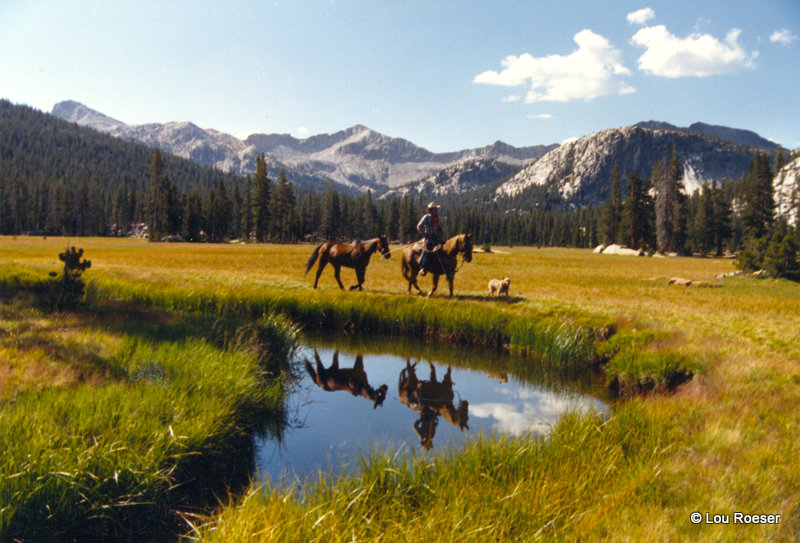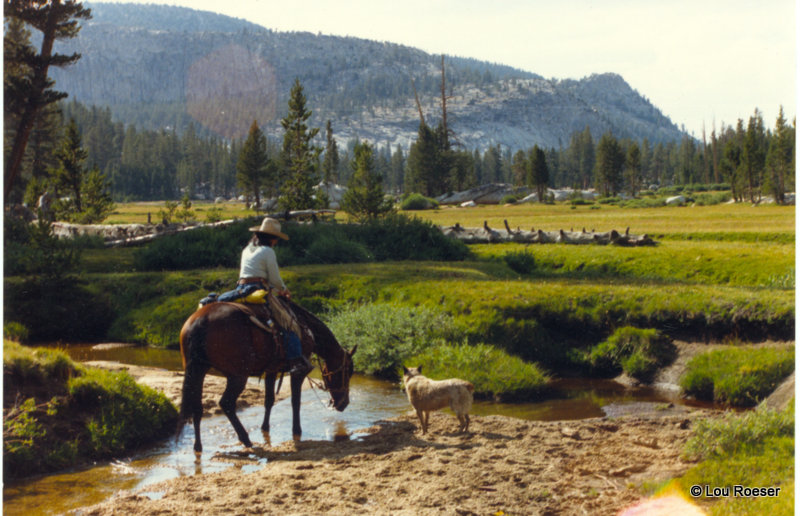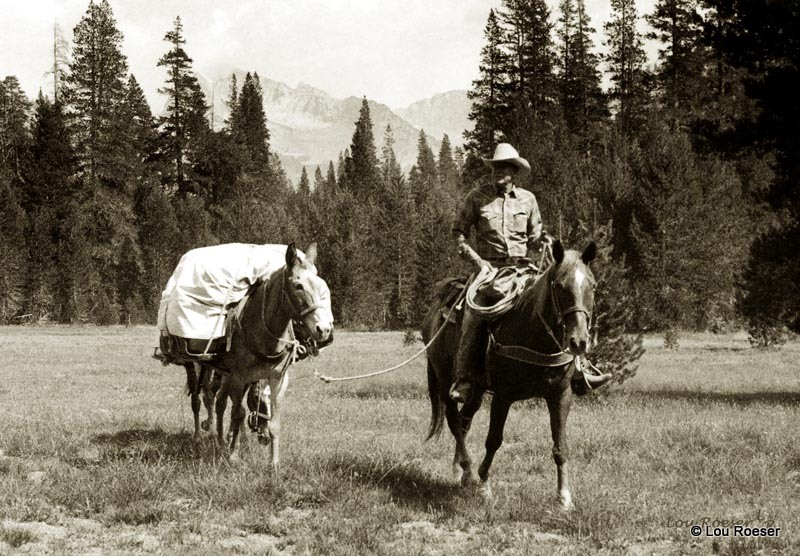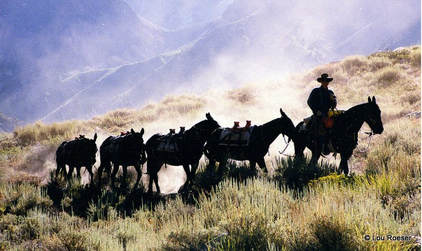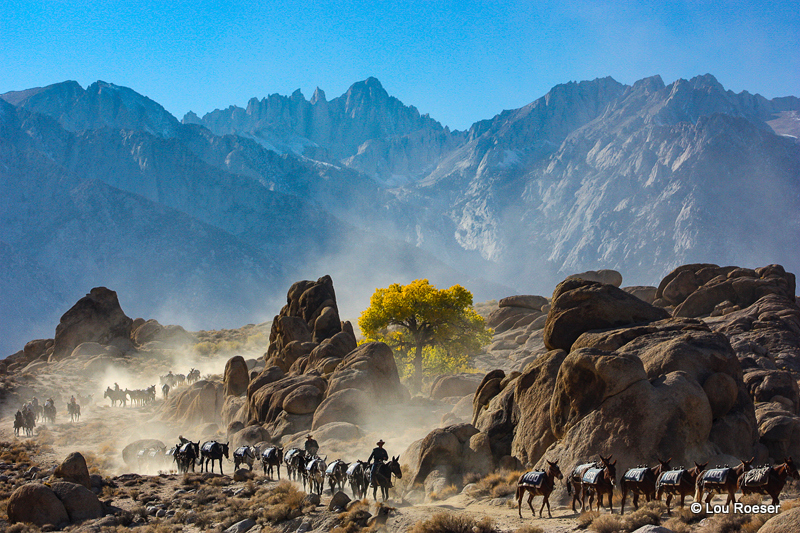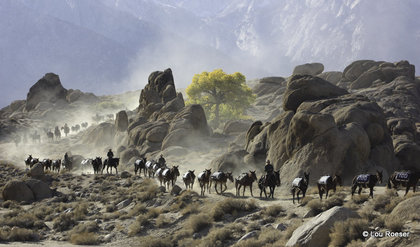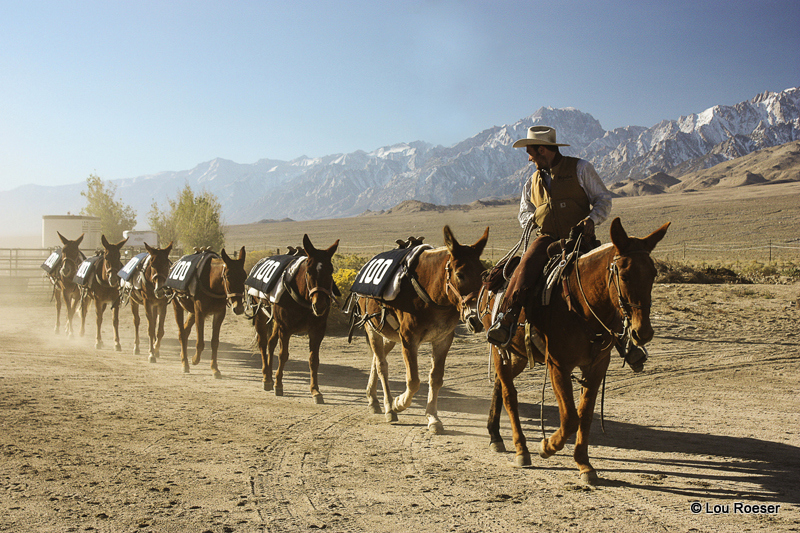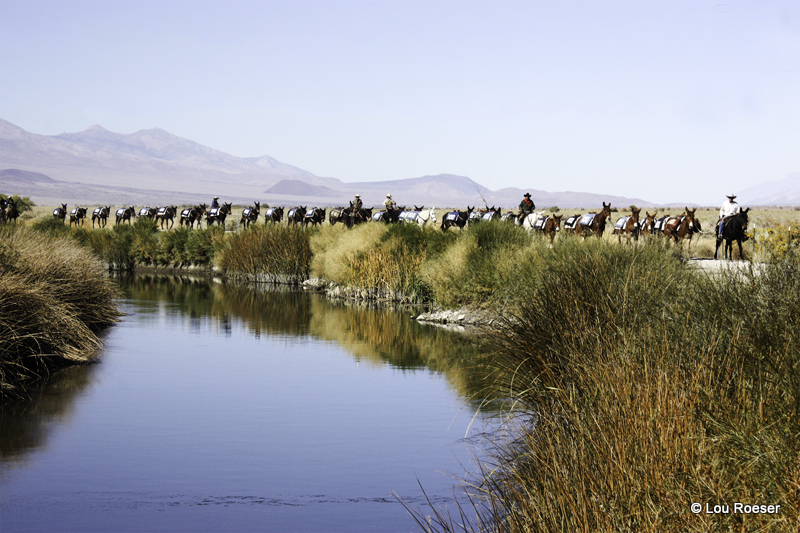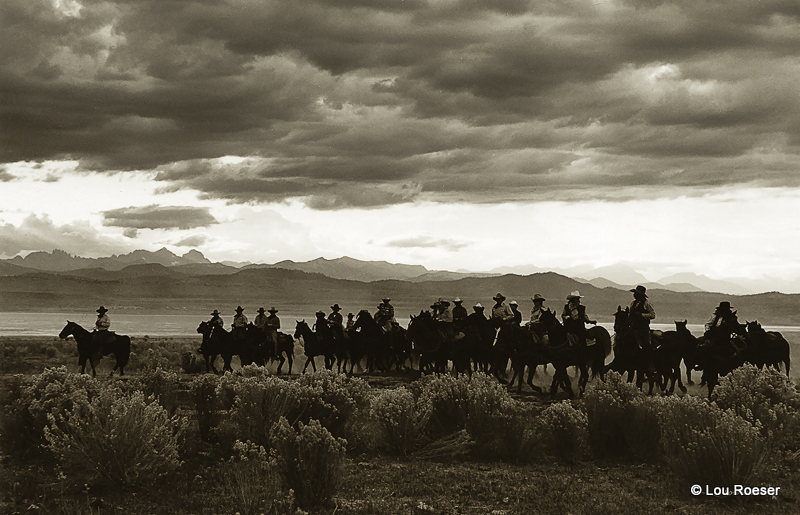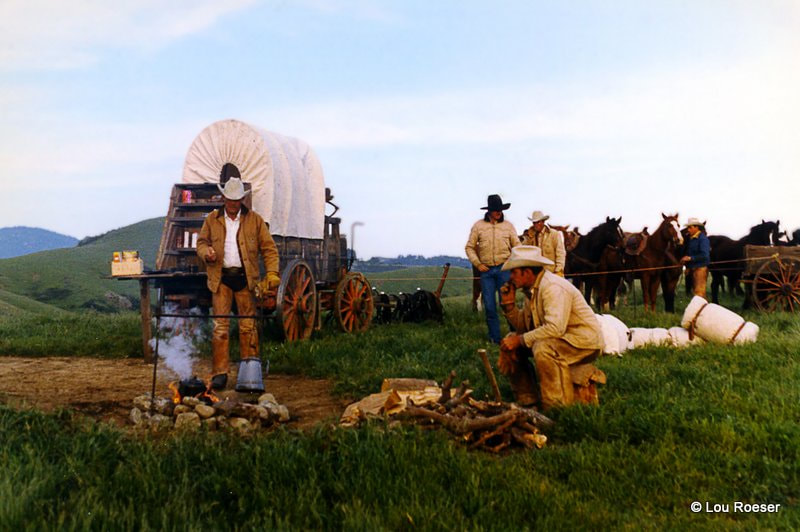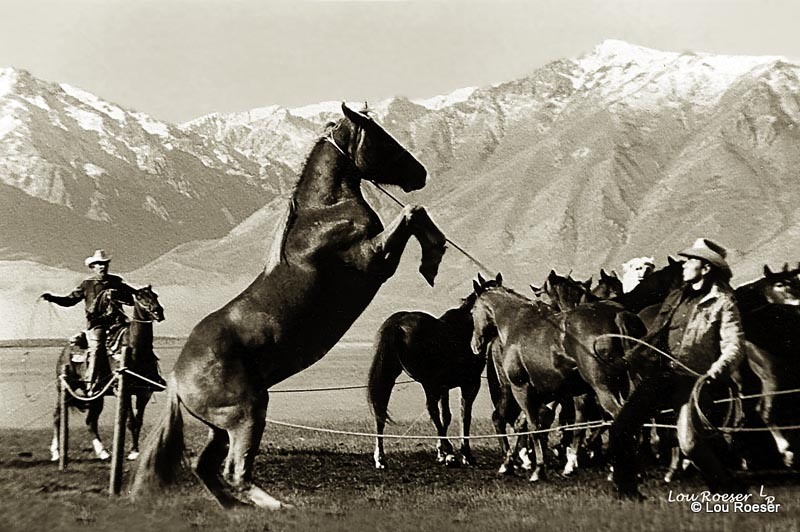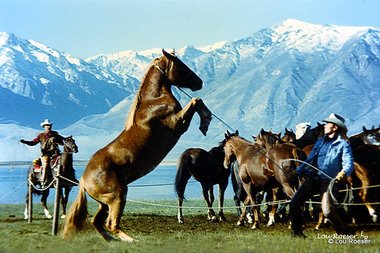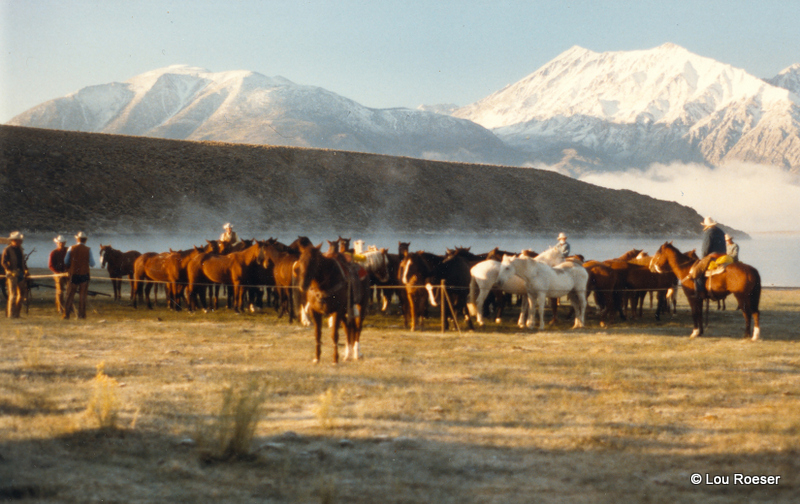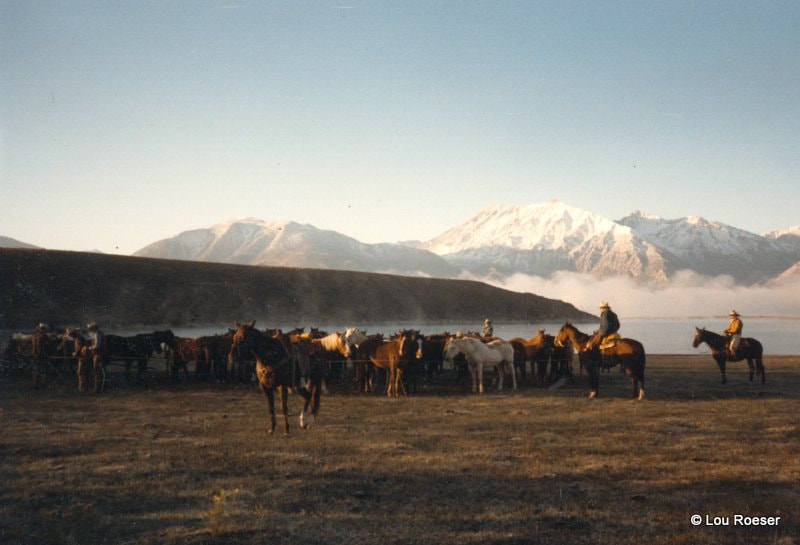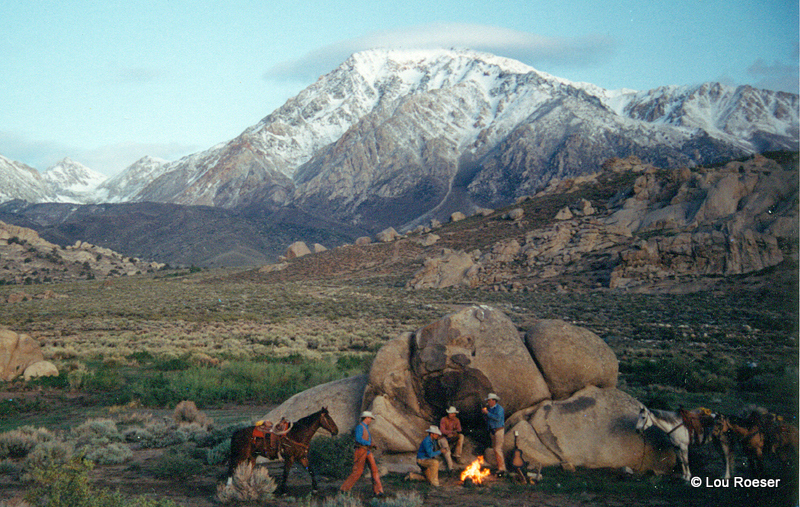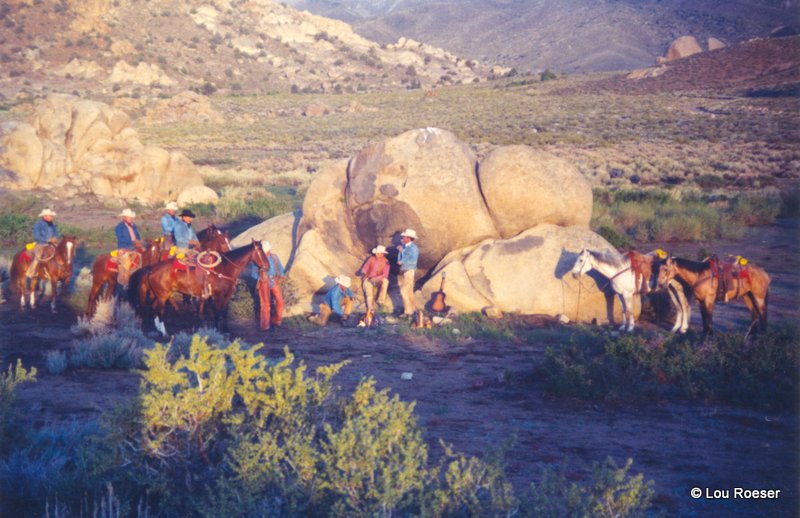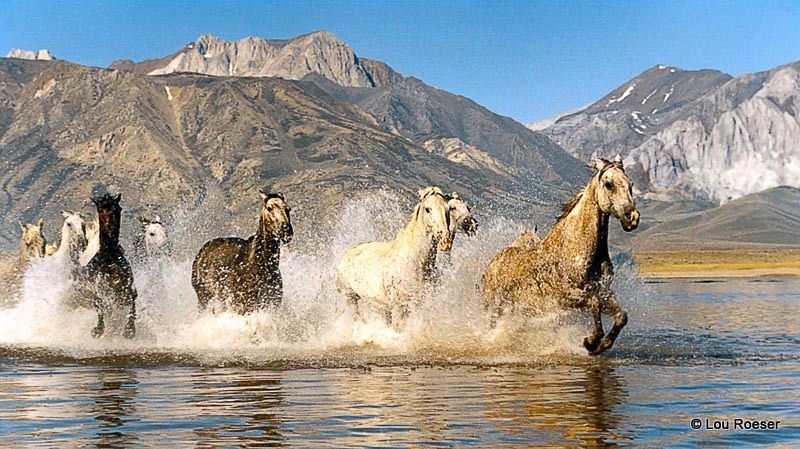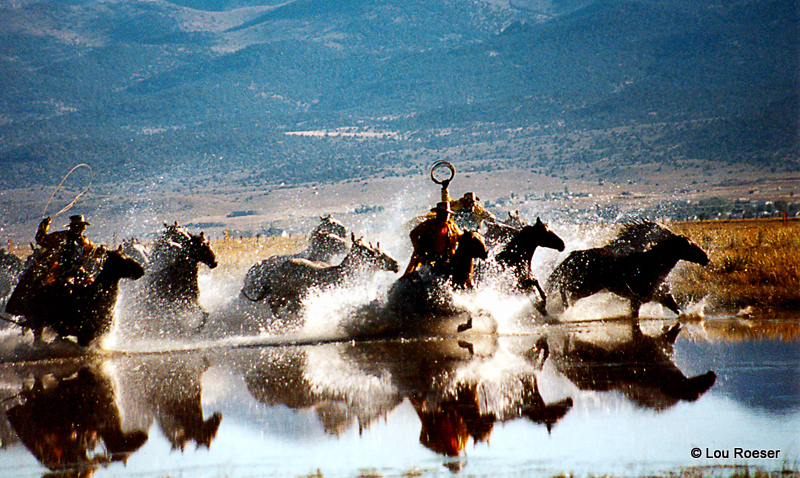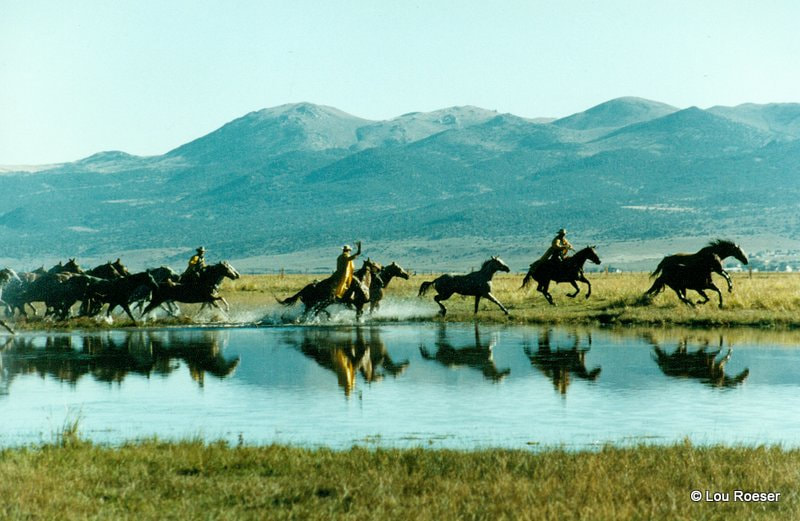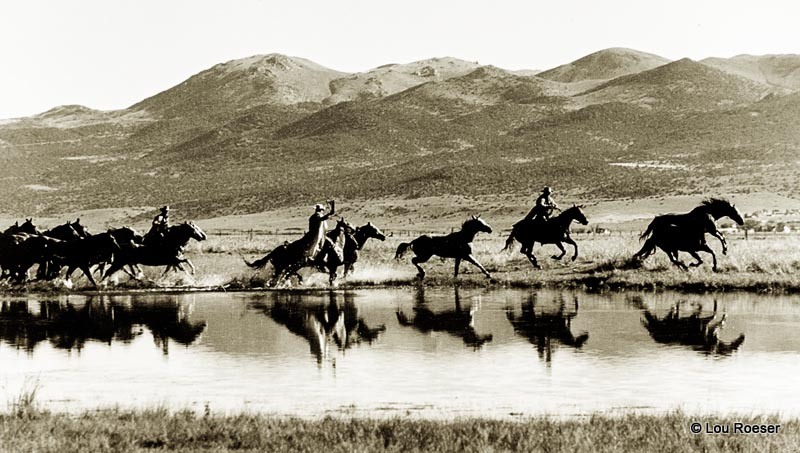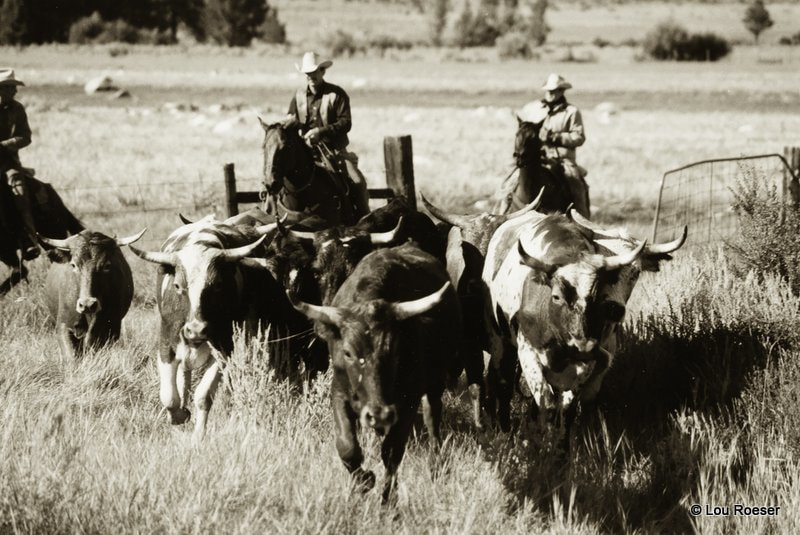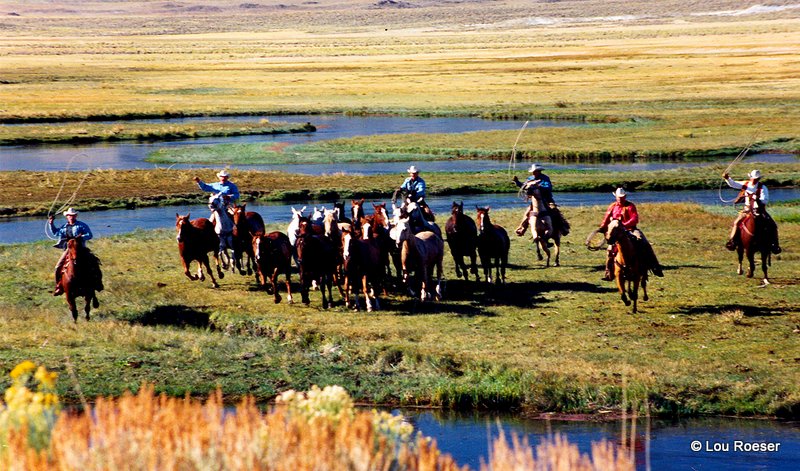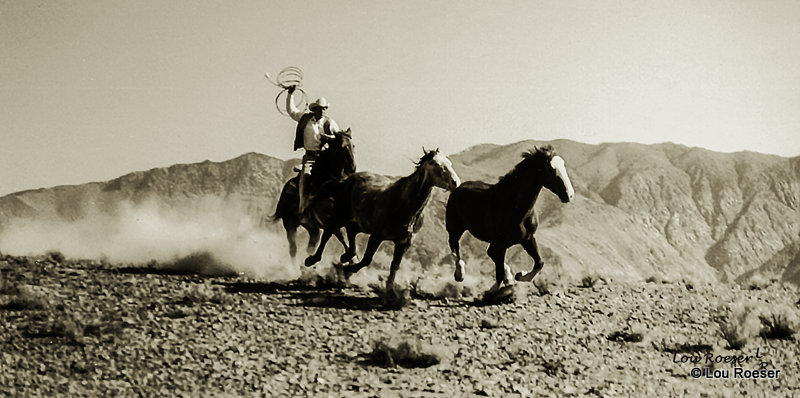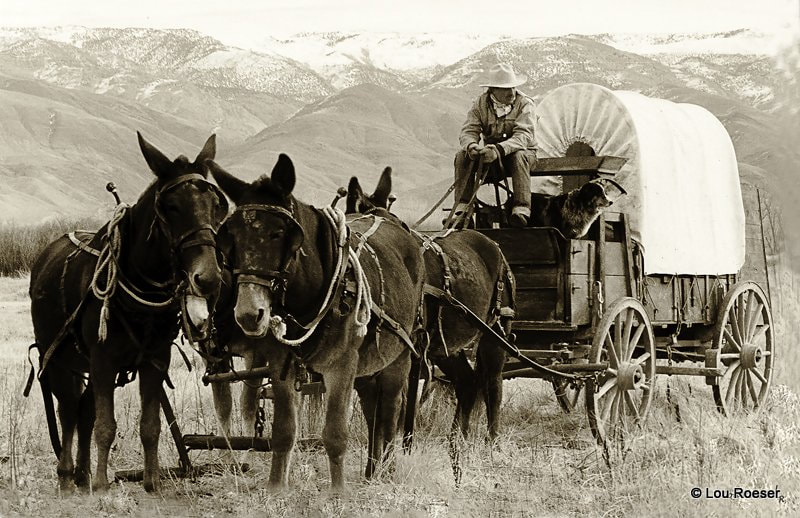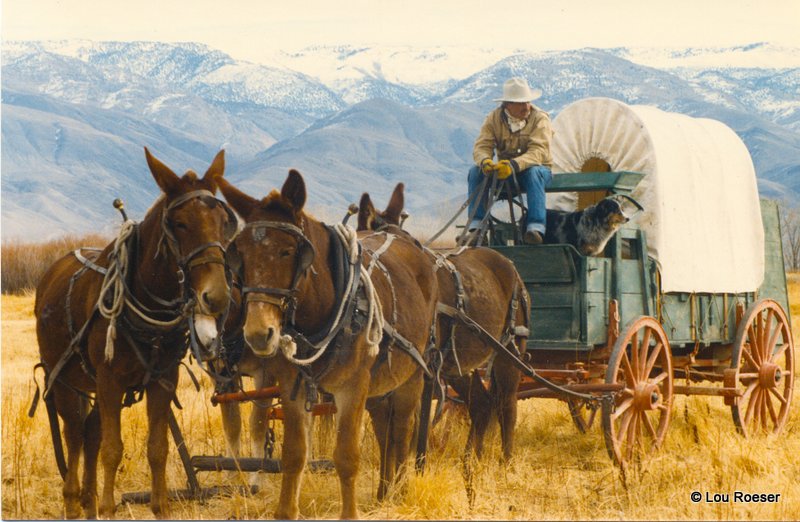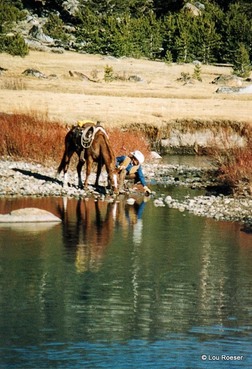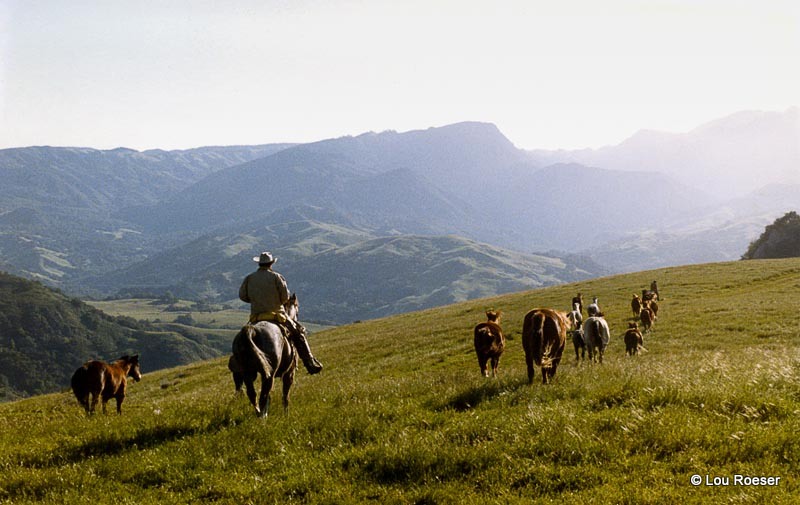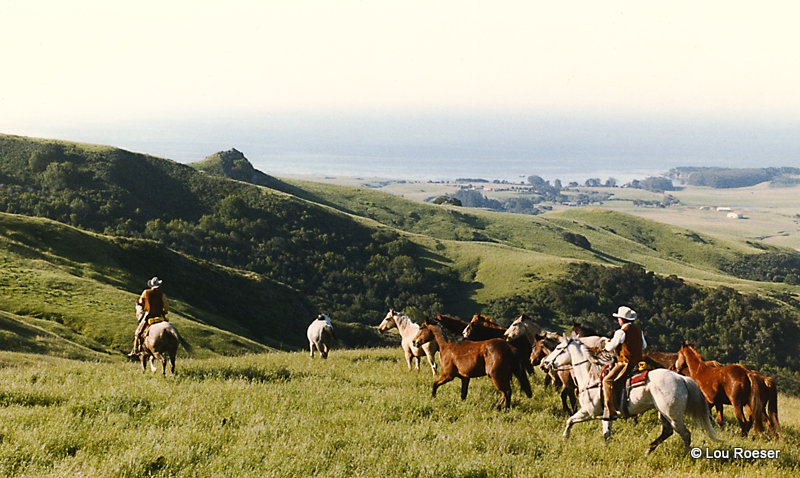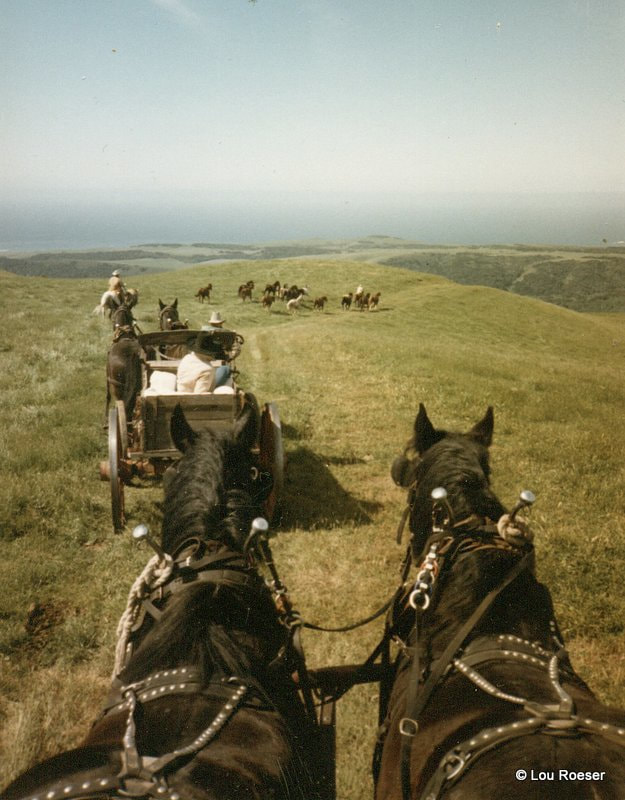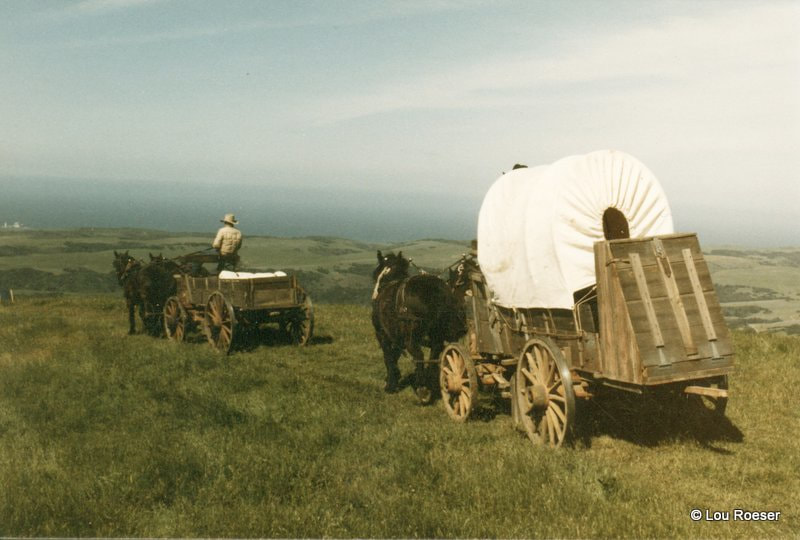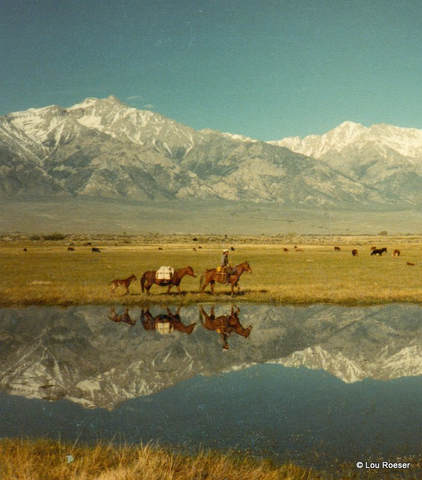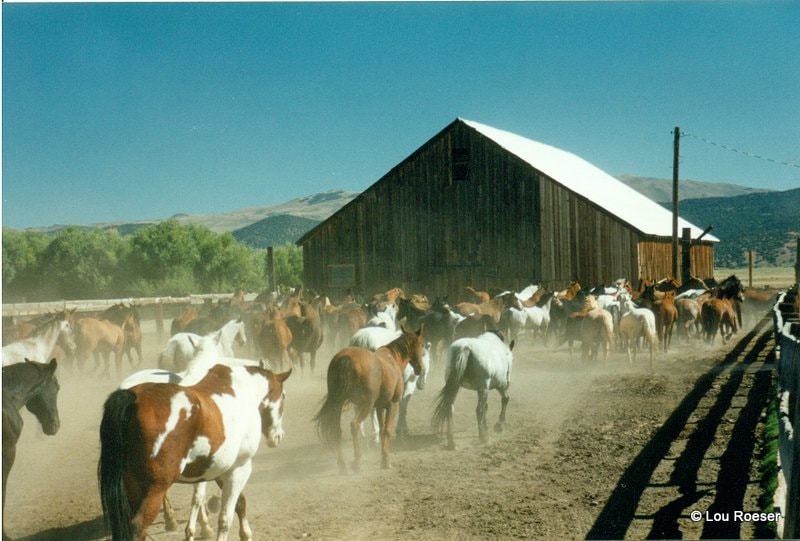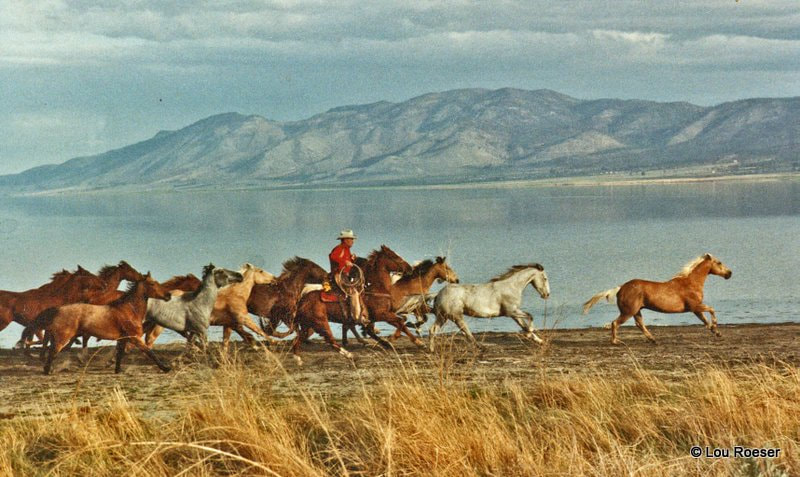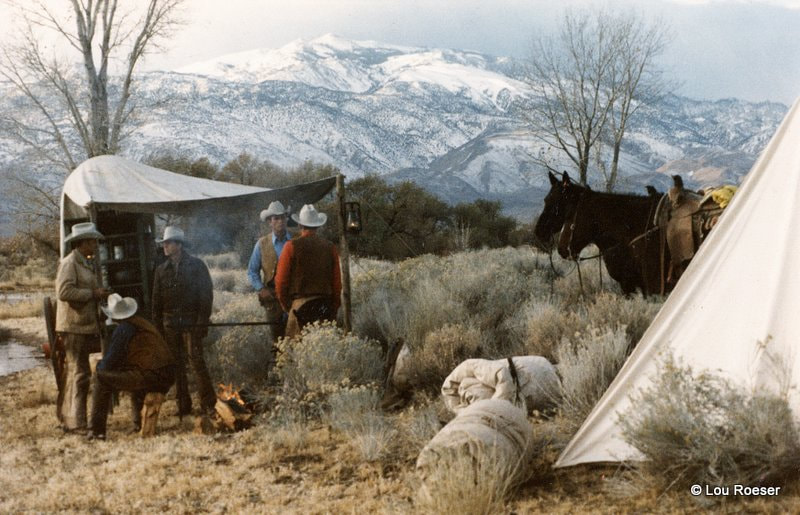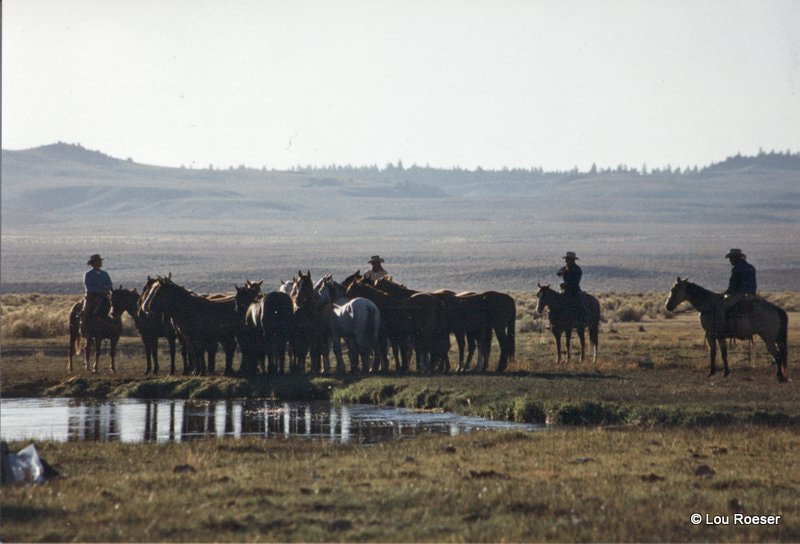While packing mules at the Mammoth Lakes Pack Outfit, Lou Roeser discovered the spectacular Eastern Sierra and found his home and life’s work. As a sideline to his livestock centered businesses, he became involved with the western film business supply livestock, wagons and teams, chuck wagon camp set-up[s, wranglers and cowboys. He located destinations and provided the film shoot set-up for many western commercials and films. He worked for Marlboro “Marlboro Country” still commercials for many years and always carried his camera to film what his business, Old West Film Outfitters, accomplished. For the first time, some these rare photo images are now available. They illustrate the working world of ranches and pack outfits both in glorious color and soft sepia. Enjoy this peek into the past. Image numbers beginning with M are from Marlboro photo shoots.
These photographic prints are individually printed on archival Epson Photographic paper with archival Epson ink and with care will last for many years. Please call or e-mail about custom sizes, canvas prints and available framing.
The photographs were taken by Lou Roeser using a Canon Camera.
For more of the stories surrounding these photos and their backgrounds see our page Roeser's Old West Film Outfitters.
These photographic prints are individually printed on archival Epson Photographic paper with archival Epson ink and with care will last for many years. Please call or e-mail about custom sizes, canvas prints and available framing.
The photographs were taken by Lou Roeser using a Canon Camera.
For more of the stories surrounding these photos and their backgrounds see our page Roeser's Old West Film Outfitters.
Please call 530-721-7925 or e-mail [email protected] for availability and pricing.
In the future some of Lou’s photographs will be available.
Photograph sizes:
11 x 14, $60.00
12 x 16, $65.00
Custom sizes are available on request.
They will be mounted on foam board and packaged in plastic bags.
Photograph sizes:
11 x 14, $60.00
12 x 16, $65.00
Custom sizes are available on request.
They will be mounted on foam board and packaged in plastic bags.
|
P-2 Heading to Camp
Jackson Meadow (in the Silver Divide Country), in the morning, is a serene and tranquil bit of “Heaven”. Despite the lush grass, some horses can be “bunch quitters”, always wanting to go home and this horse, favored that sentiment. She had been tied to a high line while the rest of the horses and mules grazed. Then she had her grazing time, close to camp, while the others were tied up and saddled for the day’s ride. Now, she is docilely being led back to camp by the packer to be brushed and saddled. |
|
P-5 “The Pause that Refreshes”
Marye Roeser and her Queensland dog, Reb, are pausing to water her horse in Minnow Creek, in the Silver Divide country. Camp is in Jackson Meadow a lovely camping area in the John Muir Wilderness of the California Sierra Nevada where she will prepare a satisfying campfire dinner. |
|
P-7 Packer With String - Cascade Valley sepia
Cascade Valley is a jewel located in the John Muir Wilderness Area of the Mammoth Lakes backcountry. Fish Creek, a large stream that lives up to its name, cascades through the valley providing fishermen with ideal fly fishing opportunities. Packers loved the large meadows with plentiful grazing for their horses and mules and ideal campsites tucked away amid the pine forest. This packer is looking forward to reaching camp and settling his party for their camping vacation in the Sierra. |
|
P-8 “Pack String on Laurel Pass Trail”
color or sepia The packer, Gary McCoy, is on his way back to the pack station after packing in a family group to a base camp on a lovely Sierra Lake. His packs are empty. In a week, he will take the stock back in and pack out the party to civilization after a serene vacation of fishing, hiking and camping. |
|
100-1 “100 Mules Walk with Mt. Whitney Looming Above”
In 2013, the 100 year Anniversary of the completion of the Los Angeles Aqueduct occurred. The Los Angeles Aqueduct, begun in 1908, employed thousands of mules in the construction and was engineered to bring water from the Sierra’s eastern side to Los Angeles. In commemoration, 100 mules symbolizing 1 mule for each year, made the month long trek from the aqueduct intake north of Independence, Calif. 248 miles to Griffith Park in Los Angeles, CA. A crew of 35 led the journey camping out along the route following aqueduct. In this photo taken of the packers and mules trailing through the Alabama Hills, Mt. Whitney looms above the pack strings who are wearing their special blankets emblazoned with the numerals 100 adorning their sides. |
|
100-3 100 Mules walking in the Alabama Hills
The third Day of the month-long journey traversed the beautiful Alabama Hills, of Western movie fame, before dropping into Lone Pine to camp at the Rodeo Grounds. Here, they were greeted and welcomed by the public visitors and camped for the night. The next morning, they continued on their long walk to Los Angeles over 200 miles away. |
|
100-6 100 Mules Begin Long Trek at Owens Valley Aqueduct
Lee leads the way knowing they would be a month on the trail, camping out along the way. Local and long distance fans welcomed and cheered them on as they began their long trek honoring the mules’ role in construction of this historic aqueduct. |
|
H-2 Riders on the Long Fall Drive sepia
A horse drive has been said to be more a “Whoa!! And less “Go!” than a slow paced cattle drive. On the semi-annual Mammoth Lakes Pack Outfit Horse Drives, the riders in the front of the remuda hold back the fresh and eager horses and mules who want to hurry to get to where they know they are going. Here near Crowley Lake, the vanguard has slowed to gather the herd before proceeding to camp for the night. On the sagebrush flat, the front line spreads out while the slower, older stock catches up. Each Spring and Fall, the Pack Outfit drives their horses and mules between winter pasture near Independence and summer headquarters in the mountains, a distance of over 100 miles. |
|
M-1 “Chuck Wagon Round-up Camp” sepia or color
Cowboys always enjoy a welcome cup of cowboy coffee in round-up camp as the work is hard and the days are long. At the Hearst Cattle ranch in San Simeon, California, along the Pacific coast, an authentic cowboy camp, complete with a well- stocked chuck wagon and tents, is set up making the cowboys “out on the range” home comfortable. In cowboy lingo this was known as “out with the wagon” and on large ranches, cowboys were often out for weeks at a time. The horse remuda meanwhile have been gathered in a rope corral. |
|
M-2 “Roping the Remuda”
At a round-up camp on the northern shore of Crowley Lake, the horse remuda are rounded up into a rope corral from the night pasture. The cow boss will rope the horses he wants used on this day. A cowboy will then lead the horse out of the corral to be bridled and saddled. This young green broke horse isn’t sure he knows what is expected of him today. A green horse will be a handful on today’s gather. |
|
M-3 “Crack of dawn – the Long Drive” color
With fog rising off Crowley Lake and swirling under the High Sierra peaks, the horse remuda is run into the rope corral from their night pasture. The cow boss will select the day’s mounts and assign them to each cowboy. Using a hoolihan throw, the cow boss or a cowboy will rope or catch the selected horse and lead him out of the corral to be saddled and bridled for the day’s work of rounding up and sorting the cattle. This photograph was taken just after dawn on the northern side of Crowley Lake near Layton Springs. |
|
M-4 “Rope Corral – Frosty Morn”
color or sepia This photo taken on the north side of Crowley Lake at dawn showcases traditional Round-up Camp activities. A rope corral was set up in the meadow and the horse remuda run inside from their nighttime holding pasture. The cow boss will select the day’s mounts and assign them to each cowboy. Using a hoolihan throw the cow boss or a cowboy will rope or catch the selected horse. The chosen horses to be used this day in the cattle round-up are roped and led outside to be bridled and saddled. With warm jackets to ward off the frosty morning and low lying lake fog, Cowboy Outriders will watch for any “runaways”. |
|
M-5 Round-up Camp - Big Rock
At the round-up camp at Big Rock, Basin Mountain has a fresh blanket of snow and it is time to move cattle and horses to the lower valleys for winter grazing in the Eastern California Sierra country. Fall mornings are brisk and the cowboys enjoy the warmth of the campfire and a steaming cup of coffee before continuing the day’s work. |
|
M-6 “Round-up Camp – Coffee’s On”
Fall mornings are chilly in the Eastern Sierra and cowboys look forward to a coffee break and a chance to warm their hands. Horses and cattle are moved out of the high country in the Fall and driven to the lower valleys where winter is not so fierce. This location is in “Buttermilk Country”, in the Sierra foothills near Bishop, Calif. |
|
M-9 “Silver and Gold” “
The light colored horses are splashing along the shore of Crowley Lake are being driven to new pastures. The morning sunlight shining through the water sprays gilds the shiny coats of the horses with silver and gold contrasting with the blue sky and water. Marlboro advertising for a few years was built around running horses through splashing water (cool and fresh) and they sometimes wanted light colored horses and other times a mixture of light and dark. The Sierra Crest behind the running horses shows white granite rock of Mt. Morrison contrasting with red sedimentary rock as a background for the spectacular scene. |
|
M-11, “Turn the Cavvy”
The horse remuda splashes across a pond in the flooded meadows and the wrangler crew keeps the herd moving to dry ground. A horse wrangler yells “Turn the Cavvy” as the herd needs to be turned toward an open gate leading toward the corrals and barn where they will be saddled and bridled for the day’s ranch work. This photograph was taken at a pond in a grassy field on the Hunewill Ranch in Bridgeport, CA. |
|
M-12 , “Running in the Remuda” sepia or color The horse cavvy splashes across a pond in the flooded meadows and the wrangler crew keeps the herd moving to dry ground. At the ranch barn and corrals, wranglers will saddle and bridle the saddle horses for ranch work by the early morning riders. The photograph was shot early in the morning at a pond on the Hunewill Ranch in Bridgeport, CA. |
|
M-13 “Splashing Through the Pond – Turn ‘em, Boys”
sepia The horse cavvy splashes across a pond in the flooded meadows and the wrangler crew keeps the herd moving to dry ground. At the ranch headquarter’s large barn and corrals, the horses will be saddled up for ranch work and used by the early morning riders. This photograph was shot early in the morning on the Hunewill Ranch in Bridgeport, California. |
|
M-16 “Bringing In the Corrientes”
sepia Western photographers like to film Corriente cattle as they look similar to Texas longhorns but are much easier to sort, handle, and move. Here, cowboys are moving a small group of Corriente steers toward a ranch gate. This photograph was shot in Long Valley, CA near the Upper Owens River. |
|
M-17 “Gathering the Remuda in Long Valley”
The Upper Owens River meanders through grassy fields and pastures providing rich summer grazing for cattle and horses at an elevation of 7,000 feet. This bunch of horses is being moved to another pasture and was filmed on the Arcularius Ranch in Long Valley, CA. |
|
M-18 “Bringing in the Bunch Quitters” sepia As the horse herd is driven toward their winter pasture, a couple of bunch quitters decide to go off on their own and leave the herd. Quick responding cowboys, cut the renegades off and return them to the herd. This photograph was shot in Olancha, CA near the Olancha sand dunes. |
|
M-19 “Chuckwagon Waitin’ for the Herd”
he Cowboy camp cook and his helper, both experienced teamsters, will drive the chuck wagon (camp kitchen) and the bed wagon (the bedrolls and tents) to the next round- up camp location following the cattle and horse herd. Reliable Mules will patiently wait until the driver signals them to start out moving forward and an Australian shepherd dog gets a ride in the wagon until she is needed to help drive the herd. This photograph was shot on a ranch in the Owens Valley near Lone Pine, California. |
|
M-21 “Cool Drink of Water”
A packer pauses to water his horse and also himself in the cool clear water of Hope Valley Creek in the California Sierra. This area of the Sierra has cattle grazing permits issued by the Forest Service. In the Fall, the cattle are rounded up by the ranchers and their crew and moved to the lower valleys for winter grazing. |
|
M-22 Wrangling the Remuda
When the fall round-up is over, the horse remuda along with the Chuckwagon and bed wagon return to the ranch headquarters. The cowboys drive and lead the horses who know where they are going and look forward to their return to the Home Ranch. This photograph was shot on the Hearst Ranch in San Simeon along the Pacific Coast. The Coast Range is well covered with the winter green grass that grows so luxuriously there and provides lush feed for the horses and cattle. |
|
M-23 Bringing in the Remuda
Fall round-up is over and the horse remuda is being driven back to the Home Ranch overlooking the Pacific Ocean. The cowboys drive and lead the horses who know where they are going and look forward to their return to the Headquarters. The advertising company that produced the Marlboro Country advertising campaign required authenticity in the photographs of working cowboys in the West. The Marlboro Men were actually working cowboys. This photograph was shot on the Hearst Ranch in San Simeon along the Central California Pacific Coast. The Coast Range is well covered with the winter green grass that grows so luxuriously there and provides lush feed for the horses and cattle. |
|
M-24 Headin’ to the Home Ranch”
The advertising company that produced the Marlboro Country advertising campaign required authenticity in the photographs of working cowboys in the West. The Marlboro Men were actually working cowboys. The Circle C Ranch in San Simeon was the location for a Marlboro film shoot that produced unique photographs of traditional ranch work. Here the Marlboro cowboys are driving the horse remuda back to headquarters near the Pacific Ocean coast. The moist ocean breezes help the green grass covering the hills and valleys of this California ranch grow lush and tall. |
|
M-25 “ Wagons Return to Headquarter’s Ranch”
The Chuckwagon and the Bed Wagon are driven by cowboys back to the Home Ranch after the Fall Round-up is over. The wagons will be unpacked, cleaned and readied for the next round-up camp in the Spring. The cowboys driving the wagons are expert teamsters able to handle the sometimes steep hills on the large ranch and are on Lou Roeser’s crew. Lou shot this photograph from the chuckwagon seat that Lou was driving. This photograph was shot on the Hearst Ranch, Circle C Ranch, in San Simeon along the Central California Pacific Coast. The Coast Range is well covered with the winter green grass that grows so luxuriously there and provides lush feed for the horses and cattle. |
|
M-28 “Sierra Reflections – Packing Salt”
Ranchers set out salt blocks for the cattle and horses and often use a pack horse or mule to access the roadless “salt licks”. This mare knows her job well and her little foal, prancing behind, keeps up with Mom. This shot was on the Lacey Ranch in Lone Pine, CA. |
|
M-30 “Big Barn at the Circle H Ranch”
This historic old barn built in the early 1880s is one of the few working barns remaining in the Bridgeport Valley from that era. It was well built with locally processed lumber and stone foundations and is central to the guest ranch’s varied horse activities. Here, the horses are run into the corrals from the horse pasture to be saddled for the day’s horseback adventures and work. |
|
M-31 “Running Horses – Honey Lake”
There are ranches along the edge of Honey Lake that, when the lake is filled with water, have wonderful views across the water to the Diamond Mountains. In this photograph, the horse remuda is being moved to another pasture along the water filled shoreline of Honey Lake, near Susanville, CA. During the drought Honey Lake became almost dry but the winter of 2017 filled the lake again with water up to the lakeside ranches. |
|
M-32 "Running Horses – Hunewill Pond”
|
|
M-40 “Early Morning Coffee”
color or sepia The chuckwagon camp is set up near a pond in late fall where the cattle are being rounded up and sorted before moving them to the winter ranges. The horse remuda has been brought in and the chosen saddle horses for today’s ride are saddled and bridled. A cup of coffee, just at dawn, is savored by the cowboys as they get ready to ride out. The saddled horses are also ready for today’s work. This photograph was shot at dawn north of Bishop, California. |
